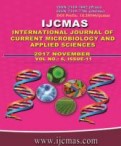


 National Academy of Agricultural Sciences (NAAS)
National Academy of Agricultural Sciences (NAAS)

|
PRINT ISSN : 2319-7692
Online ISSN : 2319-7706 Issues : 12 per year Publisher : Excellent Publishers Email : editorijcmas@gmail.com / submit@ijcmas.com Editor-in-chief: Dr.M.Prakash Index Copernicus ICV 2018: 95.39 NAAS RATING 2020: 5.38 |
In this study thirteen isolates of Burkholderia sp. were isolated from the root, stem and leaf samples of four different crops viz., rice, maize, sugarcane and blackgram, using N-free Burkholderia Azelaic acid (BAz) semi solid medium. Based on growth performance on different media the following isolates viz., RB1 (Rice Burkholderia 1), MB2 (Maize Burkholderia 2), SB3 (Sugarcane Burkholderia 3) and BB4 (Black gram Burkholderia 4) were selected for further studies. Among the four isolates, BB4 isolate showed the maximum nitrogenase activity (81.74 n moles ethylene produced h-1 /mg of cell protein) followed by SB3, RB1 and MB2. Interestingly the cell protein content (1.54 mg g-1), ammonia excretion (10.04 ïÂÂg ml-1), polysaccharide production (28.82 mg g-1) and hydrogen cyanide production (44.42 ïÂÂg ml-1) were also observed more in BB4 than others. Further the Pot culture experiment was carried out to evaluate the effect of best N2 fixing selected isolate (BB4) on the growth of maize. The maximum germination percentage (83.3 per cent) was observed in the maize when it was treated with Burkholderia + 100% N + P fertilizer. At the same time after 60th day of sowing higher shoot (59.7cm) and root (32 cm) growth of maize was observed when it was treated with Burkholderia + 100 % N + P, which was on par with the treatment with Azospirillum + Phosphobacteria +100 % N and P. Therefore it is clear from the above observation that Burkholderia sp (BB4) may be useful as a cost effective bio fertilizer to promote sustainable agriculture.
 |
 |
 |
 |
 |